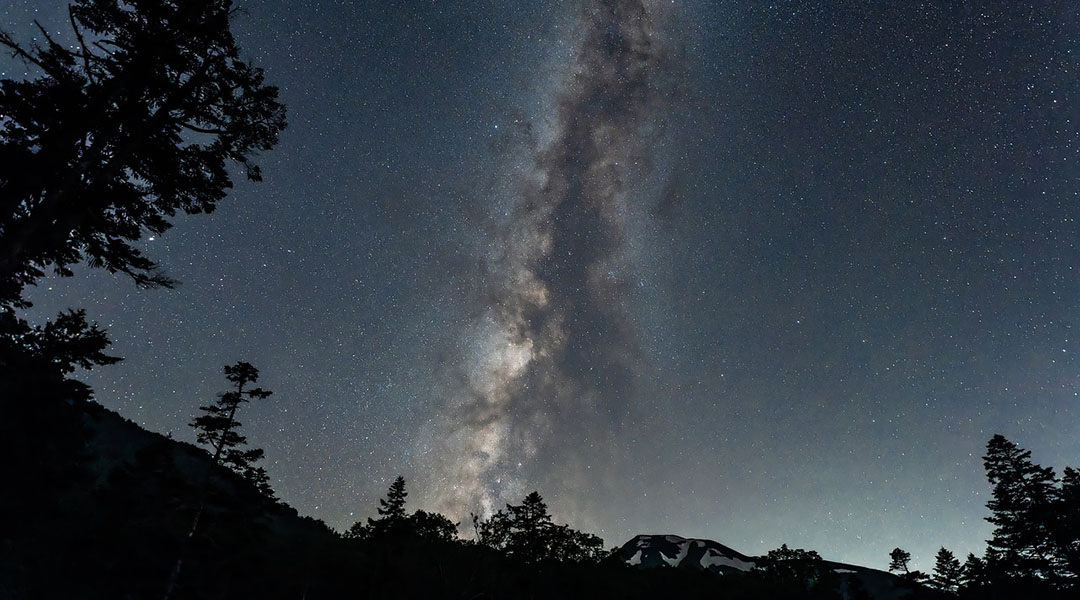Let’s start with a controversial claim: I don’t believe dark matter and dark energy exist. I think these ideas stem entirely from a misguided assumption about the laws of physics.
The idea of dark matter arose about a century ago, when astronomers looking at distant galaxies noticed they were moving a lot faster than their observable mass would allow, according to our laws of gravity and relativity. Scientists then believed, and still do, that there is some “missing” mass within galaxies which accounts for these higher-than-expected velocities. Coined dark matter, it is thought to account for 85% of all mass in the Universe, with “normal” matter accounting for the remaining 15%. The existence of dark matter was inferred by the fact that observation didn’t fit our model of gravity.
But what if the reason galaxies appear to be moving and rotating faster than they “should be” isn’t because there is extra mass that we cannot detect, but because our models are wrong? What if we took a dialectical approach to cosmology, and what lines of inquiry would flow from that?
We know that classical mechanics — the laws which govern the motion of objects on the macroscale – do not apply to things which are very small, and that instead they must be described by quantum mechanics. The Universe has, therefore, been divided into two realms: the quantum world and the macroscale world, each with their own laws of motion.
The laws of motion for snooker balls on a snooker table work perfectly well enough to also describe the laws of motion for satellites in orbit around the Earth and the Earth orbiting the Sun. Astronomers assumed these same laws apply to galaxies too.
But what if they don’t? Might that explain why they’re moving faster than our laws predict because we’re using the wrong laws? Perhaps there is a third scale of mechanics after quantum mechanics and classical mechanics: galactic mechanics.
Galactic mechanics
Before going further, I should admit that I am not an astrophysicist and I can appreciate that writing as a non-expert opens this article up to ridicule. However, astrophysicists have thought up similar ideas, and with more mathematical and scientific rigor, than I could ever hope to achieve.
Mordehai Milgrom is an Israeli physicist who in 1983 published his idea of modified Newtonian dynamics, or MOND, in the Astrophysical Journal. In MOND, there is no need for dark matter, and instead, the velocity and rotation of galaxies as we observe them are explained by a modification to classical physics that only applies to systems as vast as galaxies.
As with all new theories, not everyone is convinced. Indeed, the theories of dark matter and dark energy continue to dominate modern astrophysics. But as we know from the history of science, and in particular astronomy, consensus or majority agreement on a theory doesn’t necessarily mean it is the right one.
Looking at the world from the standpoint of dialectical materialism, MOND — or a theory like it — seems far more plausible (at least to me) than the existence of an elusive substance which has only been hypothesized as a fudge to make sure observation fit the theory, rather than the theory fit the observation.
In fact, there are some clues that scale, and the laws that apply at different ones, behave and emerge in a dialectical way. Looking at the quantum-scale world, a paper published last year by Marco Michel and Sebastian Zell highlighted a new idea called quantum breaking. This is the hypothetical point at which a system, which can be described using classical physics, eventually “breaks down” over a certain time and can suddenly only be understood using quantum physics.
This is essentially a question of where the boundary between the “classical” and “quantum” world lies, and, as Advanced Science News previously wrote on the subject, “Although the classical description of large physical systems work well, tiny deviations from classical predictions that happen on tiny scales accumulate over time, eventually resulting in the breakdown of the classical description.”
What is this but another example of a transition from quantity into quality, of a dialectical change?
In the same way that quantum breaking describes classical mechanics as the cumulative effect of quantum mechanics, so too could MOND — or any other potential model which I’ll generally call “galactic mechanics” — be the effect of the cumulative properties of a galaxies’ individual stars, planets, and clouds of cosmic dust acting according to classical mechanics.
The exact boundary between the realm of classical mechanics and galactic mechanics might not be known, but it could nevertheless be understood as a dialectical phenomenon. The quantitative effect of individual stars, planets, and dust clouds behaving under classical mechanics giving rise to a qualitative change in the system, the galaxy, in which gravity and mass behave differently at a larger, galactic scale.
Indeed, such a dialectical idea is found in another, but a lot more recent, theory of gravity. Early this year, Jonathan Oppenheim and Andrea Russo at University College London published a pre-print paper about their new theory of gravity which, like MOND, also does away with dark matter and also dark energy. Their theory focuses on the energy behind galaxies’ rotation, rather than addressing their mass. This is how The Guardian newspaper’s science correspondent, Hannah Devlin, described the theory:
“In Oppenheim’s approach the additional energy required to keep the stars locked in orbit is provided by the random fluctuations in spacetime, which in effect add in a background hum of gravitation. This would be negligible in a high gravity interaction, such as the Earth orbiting the Sun. But in low gravity situations, such as the fringes of a galaxy, the phenomenon would dominate — and cumulatively could account for the majority of the energy in the universe.” [My emphasis]
This is again sounding familiar. Indeed, before Oppenheim and Russo’s theory, and before MOND, there had been a slow and steady increase across multiple disciplines in discoveries and insights that point towards many other natural phenomena behaving in a dialectical way.
First tremors of change
Towards the end of the last century, scientists began to realize something that worried them: Some things just cannot be predicted. This wasn’t because our mathematical models for describing these phenomena were inadequate, but that unpredictability was inherent in the mathematics itself.
Take earthquakes as an example. They happen almost all the time, but the vast majority are imperceptible except to sensitive instruments. The devastating quakes that we see in the news or read about in history are rare events, but just how rare?
In statistics, most attributes in nature follow a normal distribution pattern, commonly referred to as a bell curve. But if you analyze earthquake data over a particular time period, what you find isn’t a bell curve but a power law. That is, the larger the earthquake, the rarer it is. Furthermore, operating under a power law, there is no “average” size for an earthquake. How negligible or intense an earthquake is appears to be limitless. This is known as the Gutenberg-Richter law.
A few decades ago, with the advent of cheaper computers, mathematicians began modelling natural phenomena such as earthquakes to try and understand the reasons behind this law. Knowing the mechanics of earthquakes, they were hoping to see if the starting conditions could predict whether a quake would be small or large. But to their surprise, they found that actually, the initial conditions giving rise to any given earthquake had no bearing on the magnitude of that earthquake — the magnitude of an earthquake proved to be unpredictable.
Instead, what was found was that the fault lines in the Earth’s tectonic plates exist in a permanent condition known as the critical state. In other words, far from being a system in equilibrium, the movement of the Earth’s crust is forever poised on the brink of catastrophe.
Soon after, scientists began to see critical states in many other systems that followed power laws rather than bell curves, from the size of avalanches to forest fires, from mass extinctions to stock market crashes.
To a scientist with a mechanical view of the world, these critical states and unpredictability do not fit so easily with their common assumptions. But to someone with a dialectical view of the world, these make perfect sense, because what was surprising to the scientists may not be surprising for someone who views the world from the perspective of dialectics.
In my view, critical states are a mathematical vindication of the laws of dialectics. For instance, when considering the three laws of dialectics outlined in the last article, the constant but incremental movement of the Earth’s crust, building up pressure over time, until suddenly causing an earthquake is a real-world example of the transformation from quantity into quality.
The fact that on the surface everything looks calm, but under the surface, things are in constant motion, is also an example of the unity and conflict of opposites. When a catastrophic earthquake isn’t happening, you could say that the Earth’s crust is both stable and in motion at the same time.
Dialectics and modern science
Away from earthquakes and astronomy, modern science is also showing the validity of dialectics in other fields, such as systems theory, a transdisciplinary study of systems by which things are studied in their overall context and interrelating components rather than in a reductionist way.
The idea of “emergent properties” is a core element of systems theory, and refers to phenomena where these properties emerge from the complexity of the system itself, rather than being inherent in any given part or single aspect of the system in question.
I touched upon this in my last article with respect to water and its property of wetness, but emergent properties are found in a whole host of systems, from biochemical processes to ant colonies; from the evolution of species to AI. They are dialectical in essence, and in systems theory, the dialectical understanding that things are more than just the sum of their parts therefore finds scientific expression.
Going back to the start of this article, quantum breaking hints that classical mechanics could be an emergent property of a system comprised of particles behaving in a quantum way.
Even consciousness is believed by some to be an emergent property of the complexity of the brain and the unfathomable number of chemical interactions between individual neurons. This article is not going to delve into a dialectical materialist view of consciousness—though I do believe that treating consciousness as an emergent property and understanding it dialectically might be the best explanation we have to date for it, as it places consciousness firmly on a materialist scientific basis.
Critical states and systems behaving according to power laws, as well as complex systems giving rise to emergent properties appear to be ubiquitous in nature, and more and more researchers have over the decades slowly come to realize this.
In 2000, science journalist Mark Buchanan published an informative book on the subject called, quite aptly, Ubiquity: Why Catastrophes Happen, which gives the reader a broad overview of this fascinating insight into nature based on research in many disciplines during the last half of the 20th century, including in the science of earthquakes.
Whether or not MONDists, quantum breaking theorists, seismologists or systems theorists consider their theories and discoveries dialectical in nature, or indeed whether they consider themselves dialectical materialists, is not for me to say, but this highlights the point made in my first article in this series about the need for scientists to have a conscious philosophy.
Philosophy as a guide to research
As someone who believes in the correctness of a materialist and a dialectical worldview as opposed to others, I see in these theories and discoveries clear dialectical processes at play. This is more than can be said for other, more idealist philosophies, such as those which say that consciousness is primary and what makes reality. Unlike dialectics, this philosophical outlook tells us nothing about why the Universe and systems within it are the way they are.
Dialectics, on the other hand, I think offers a guide for general scientific inquiry. However, I stress that this my own view, and I don’t dogmatically think all scientists should be dialectical materialists. But I hope with my rough outline here I’ve shown that some areas of modern science are starting to validate a dialectical materialist interpretation of nature.
And whilst I don’t say that scientists should agree with dialectical materialism, there are some basic philosophical positions which science nevertheless needs to be grounded in if we want to further and deepen our understanding of the natural world.
Firstly, science must be unwaveringly materialist. Secondly, people doing science could benefit from being more aware that their assumptions and outlook have philosophical bases, and should be more conscious of this.
Philosophy’s role in science is overall one of caution and dialectical materialism can serve as a cautionary guide to scientific development. Conversely, one should be cautious to not fall into other philosophical pitfalls, or at least be aware of the philosophical and ideological context of a given theory.
It should not be forgotten that the scientists of the Enlightenment were not just studying the world as objectively as possible because they thought that was a nice idea. They were consciously fighting an ideological battle against the old feudal order, a major pillar of support of which was idealist and mystical ideas about nature. Reason and rationality, of which modern science was borne, were ideological products of the great and stormy events of the 17th and 18th centuries. It is not by accident that many of the great scientists and thinkers of this age were supporters of the French Revolution.
Today, in some areas of science there is a creeping mysticism of ideas that essentially belong to the pre-scientific age, but which are unfortunately taken seriously amongst some people as legitimate science. This needs to be pushed back against if science is to continue to play a progressive role in society. If I admit to being dogmatic about anything it is only this: Matter and reality exist objectively, independent of subjective conscious experience, and they can be studied and understood objectively.
Being aware of this basic fact, scientists will not fall into idealist traps, such as concluding that reality is instead subjective and our observation of matter is what brings it into being.
I’ll end with a quote by Richard Lewontin, an evolutionary biologist and contemporary of Stephen Jay Gould, who said:
“Dialectical materialism is not, and never has been, a programmatic method for solving particular physical problems. Rather, a dialectical analysis provides an overview and a set of warning signs against particular forms of dogmatism and narrowness of thought.
“It tells us, ‘Remember that history may leave an important trace. Remember that being and becoming are dual aspects of nature. Remember that conditions change and that the conditions necessary to the initiation of some process may be destroyed by the process itself. Remember to pay attention to real objects in time and space and not lose them in utterly idealized abstractions. Remember that the qualitative effects of context and interaction may be lost when phenomena are isolated.’ And above all else, ‘Remember that all the other caveats are only reminders and warning signs whose application to different circumstances of the real world is contingent.'”
More in this series:

















